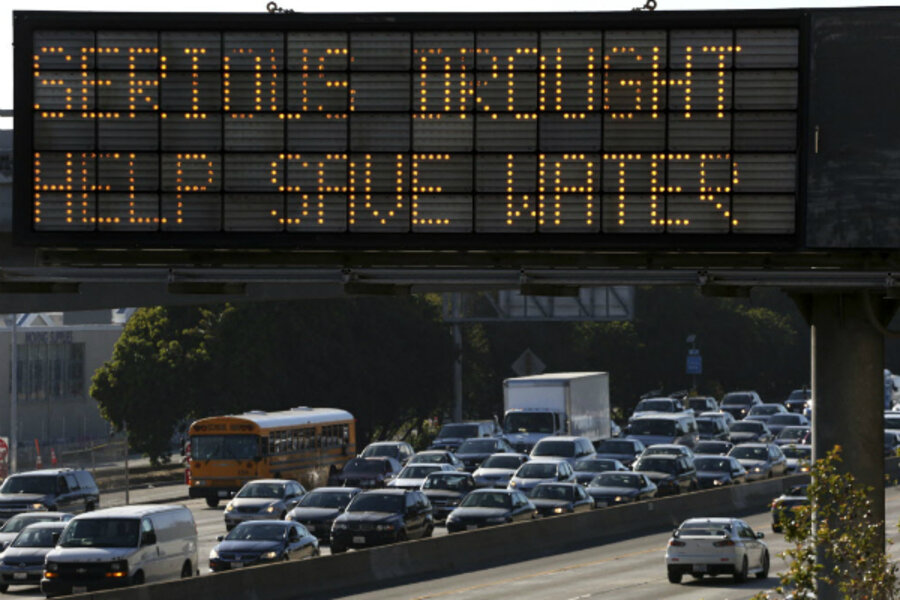Obama in California: a pledge of drought aid, climate change planning
Loading...
| Washington
President Obama visits the San Joaquin Valley on Friday to focus on California’s severe drought, and announce new measures in the ongoing federal effort to address it.
The president will also talk climate change, which many scientists link to drought and severe weather. And as promised in his State of the Union address, he will emphasize his use of executive action to get help to farmers and livestock producers as quickly as possible.
But the visuals will be California drought, as Mr. Obama visits a farm near Fresno, Calif., and holds a roundtable discussion with farmers and other local stakeholders affected by the drought. Now in its third year, the drought is California’s worst in more than 100 years, scientists say.
“He’ll offer a message of hope and a message that the federal government will do all that it can to try to alleviate some of the stress connected with this drought,” Agriculture Secretary Tom Vilsack told reporters Thursday night.
Among the measures Obama will announce is $100 million in livestock disaster assistance for California producers, and up to $50 million for previous years’ losses. Obama has instructed the Department of Agriculture (USDA) to speed up the application process to 60 days, down from six to eight months. Other areas that experienced weather disasters will be eligible for such aid.
Obama will also announce $15 million in targeted conservation assistance for the “most extreme and exceptional drought areas.” Of that, $5 million will go to California, and $10 million for drought-affected areas in Texas, Oklahoma, Nebraska, Colorado, and New Mexico. The aid helps farmers and ranchers implement conservation practices.
In addition, USDA is making $60 million available to California food banks to help families who have suffered economically from the drought. Some 600 summer meal sites for children will be established in drought-stricken areas.
As of Feb. 11, 91.6 percent of California was experiencing severe to exceptional drought, according to the latest Drought Monitor map.
John Holdren, director of the White House Office of Science and Technology Policy, also on the call with reporters, said that even though no single episode of extreme weather can be linked to climate change, a general link is clear.
“The global climate has now been so extensively impacted by the human-caused buildup of greenhouse gases, that weather practically everywhere is being influenced by climate change,” Dr. Holdren said. “We’ve always had droughts in the American West, of course, but now the severe ones are getting more frequent, they’re getting longer, and they’re getting dryer.”
As the world gets warmer, he said, a larger proportion of rainfall occurs in extreme downpours, much of which is lost to runoff. In the mountains, more precipitation falls as rain, which runs off, rather than snow, which melts gradually and feeds rivers. And higher temperatures mean greater loss of water to evaporation.
The Obama administration’s fiscal year 2015 budget, scheduled for release March 4, will include resources for “climate resilience,” said Secretary Vilsack.
Last November, Obama issued an executive order establishing a task force aimed at making US communities more resilient to extreme weather and its effects, such as droughts and floods.
Gov. Jerry Brown (D), who declared a statewide drought emergency last month, will accompany Obama on his visit to the Fresno area. The president will also be joined by Vilsack, Commissioner of the Bureau of Reclamation Michael Connor, California’s two Democratic senators, Dianne Feinstein and Barbara Boxer, and Rep. Jim Costa (D) of California, who represents Fresno.
On Tuesday, Senators Feinstein and Boxer introduced legislation providing $300 million in drought aid to California, which could increase the flow of water from northern California to the south. The bill also requires that environmental protections be upheld.
The Senate bill contrasts with a measure passed Feb. 5 by the Republican-controlled House, which would relax protection of the Delta smelt, which is listed as an endangered species in the state's environmental protection law. The White House opposes the House bill.
White House spokesman Matt Lehrich said the administration is “encouraged by the progress in the Senate” and looks forward to working with the bill’s sponsors and other members of Congress on the issue. Congressman Costa introduced the Senate legislation in the House on Tuesday.








